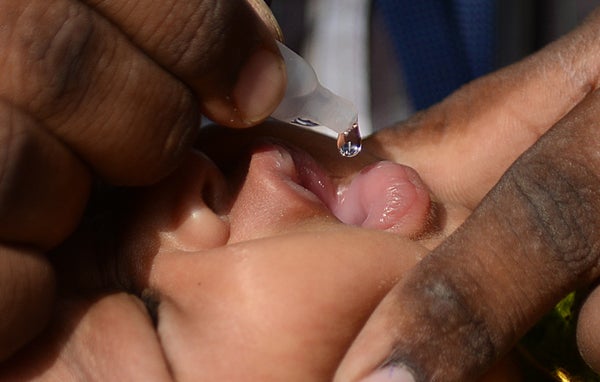This article was published in Scientific American’s former blog network and reflects the views of the author, not necessarily those of Scientific American
Last month, India celebrated its fourth anniversary of being polio free. It was an incredible achievement considering that about 150,000 cases were reported every year in the late 1970s—when I contracted polio as an infant in Bombay. I am a polio survivor, but the virus left me in the care of an orphanage, paralyzed from the hips down. Fortunately, I was adopted at the age of three and moved to America where extensive surgeries enabled me to regain some degree of mobility.
Fast forward to 2017, and there were only 22 reported cases of polio worldwide, all of which were in Pakistan and Afghanistan. We are close to achieving the global eradication of this devastating disease. But, as the saying goes, “it ain’t over till it’s over.”
According to the World Health Organization, “every year that polio persists, the risk increases that further outbreaks may take away gains made over the years, resulting in more children paralyzed.” If transmission is not interrupted in the remaining endemic countries or the global effort to end polio slows down, there is a risk that, within a decade, it would result in a resurgence of polio, with as many as 200,000 cases of paralysis each year. In financial terms, the projected savings in worldwide health costs is $40–50 billion globally by 2035 if the virus is eradicated. Ultimately, by ending polio, lives will be saved and the world would be able to dedicate the polio funds and resources to refocus attention to other preventable diseases and improving health systems.
On supporting science journalism
If you're enjoying this article, consider supporting our award-winning journalism by subscribing. By purchasing a subscription you are helping to ensure the future of impactful stories about the discoveries and ideas shaping our world today.
During the world’s final push to eradicate polio from the face of the earth, we can draw inspiration from India’s journey.
When my family first traveled to Bombay in the summer of 1989, I was struck by the visibly poor sanitation that allowed the polio virus to survive and spread. By the time I returned in 2015 to participate in India’s national immunization day campaign, a lot had changed, allowing India to win its war against polio. I believe that victory was the result of three things: partnership, open communication and innovation.
PARTNERSHIP
During my visit in 2015, I participated in a vaccination drive on the outskirts of Delhi. The community vaccinators who flanked me as we walked house to house were just three of the more than 900,000 frontline health workers responsible for ending polio in India. Much of their work was coordinated by the Indian government and the Global Polio Eradication Initiative (GPEI). Established in 1988, GPEI brought together five public and private entities: UNICEF, World Health Organization, Rotary International, the Centers for Disease Control and Prevention and, in 2007, the Bill and Melinda Gates Foundation. The Indian Government and GPEI partners also coordinated two million community volunteers who worked to ensure that all children in India under age five were vaccinated. They blanketed India’s highest risk areas with polio vaccination booths and door-to-door visits to vaccinate some 170 million children across a few days each year.
OPEN COMMUNICATION
But national vaccination days were not enough. In the early 2000s, health workers encountered Indian families who refused to allow their children to be vaccinated against polio. Among India’s Muslim community, false rumors spread that the vaccine would sterilize children, which led to parents skipping regular visits to the polio vaccination booths.
To counter this, a country-level 7,000-strong army of trained community mobilizers were organized to be influencers, part of SMNET, or “social mobilization network,” a UNICEF communication initiative to ensure every child was vaccinated for polio. Muslim clerics were consulted and encouraged to show their support for the vaccine. And with their involvement, the number of households who refused the polio vaccine declined to less than 1 percent.
INNOVATION
Still, it took enormous innovation to find the hardest to reach: the children of migrants and others in remote villages. Micro planning, data-driven analytics and satellite mapping were used to ensure that every household received the vaccine. Mobile teams of vaccinators located camps of migrant families. Children were vaccinated at railway stations, inside trains, at bus stops and market places.
As concerns about low immunization coverage persisted, India called for extra rounds of national immunization days. The number of polio cases dropped from 150,000 in 1985, to 741 in 2009, to just one case reported in 2011. That case immediately prompted
three mop-up rounds of vaccination and house-to-house visits that identified every vulnerable child in the area. The seven-week campaign stopped transmission of the virus, and no cases have been reported in India since.
FINAL PUSH
Today, Afghanistan and Pakistan, the two countries still experiencing cases of polio, as well as
Nigeria, who has passed the one-year mark of no cases reported, are pressing toward zero cases using many of the same tactics that were successful in India. In Pakistan, the government and GPEI partners have more than 200,000 front-line vaccinators and set up 600 transit posts to immunize children in high-risk areas. In Afghanistan, religious leaders—dubbed “Mobile Mullahs”—visit families to talk about Islam’s support of the vaccine.
Of course, no two situations are alike, and each country has its unique circumstances. Further, a recent
study about the impact of insecurity on polio eradication efforts indicate some children are missed in areas of high conflict and danger. So, this final push for total global eradication will not be easy. There may still be setbacks. But India proved the virus could be eliminated under the most complex of circumstances. Its success can be replicated, applying the same approach of partnership, open communication and innovation.
